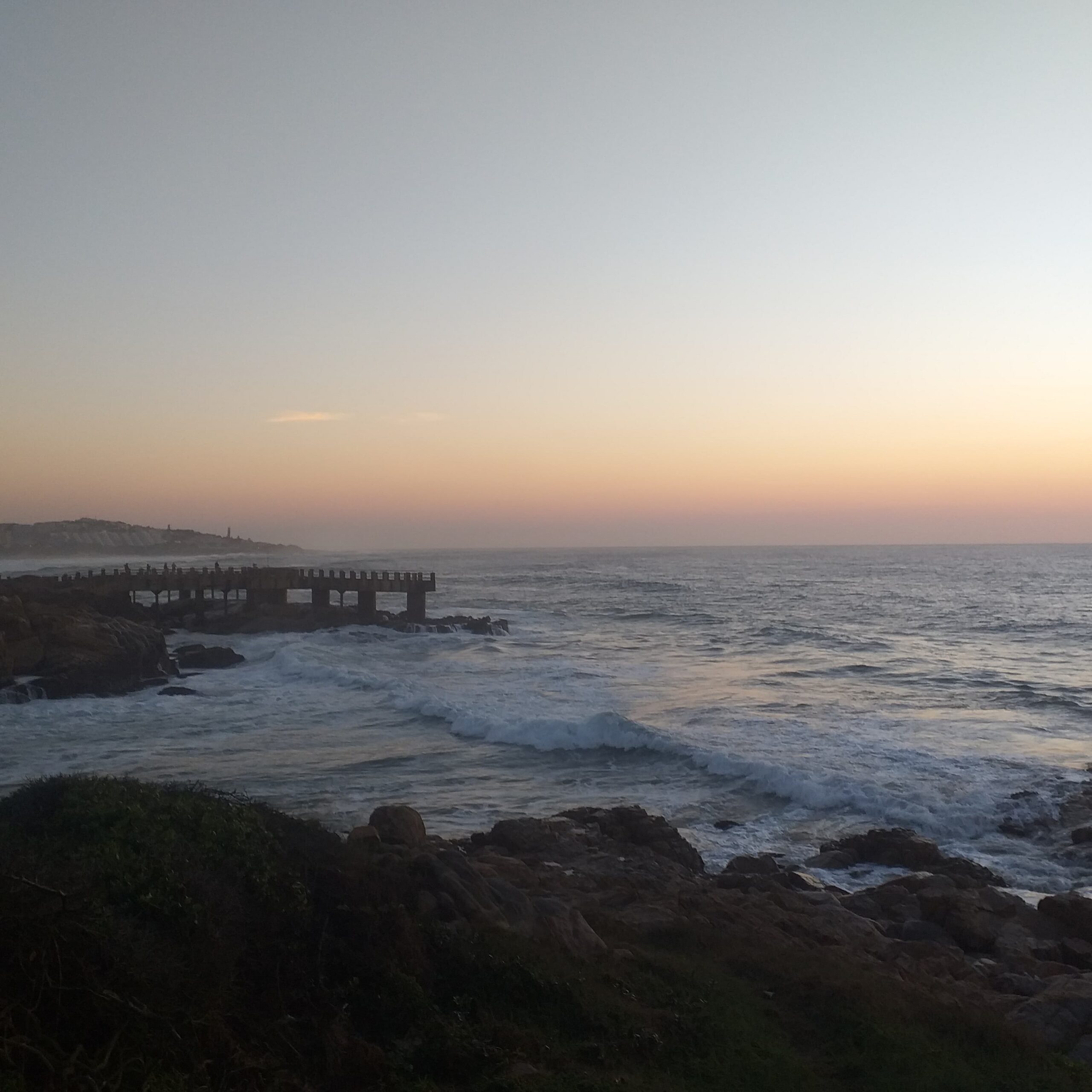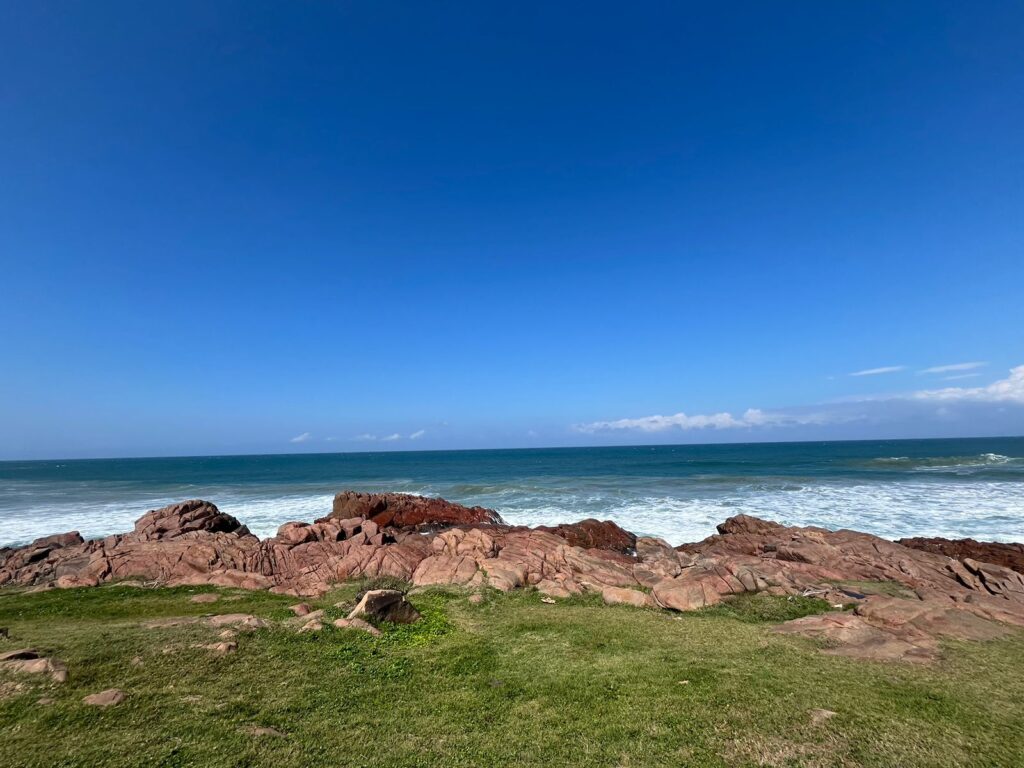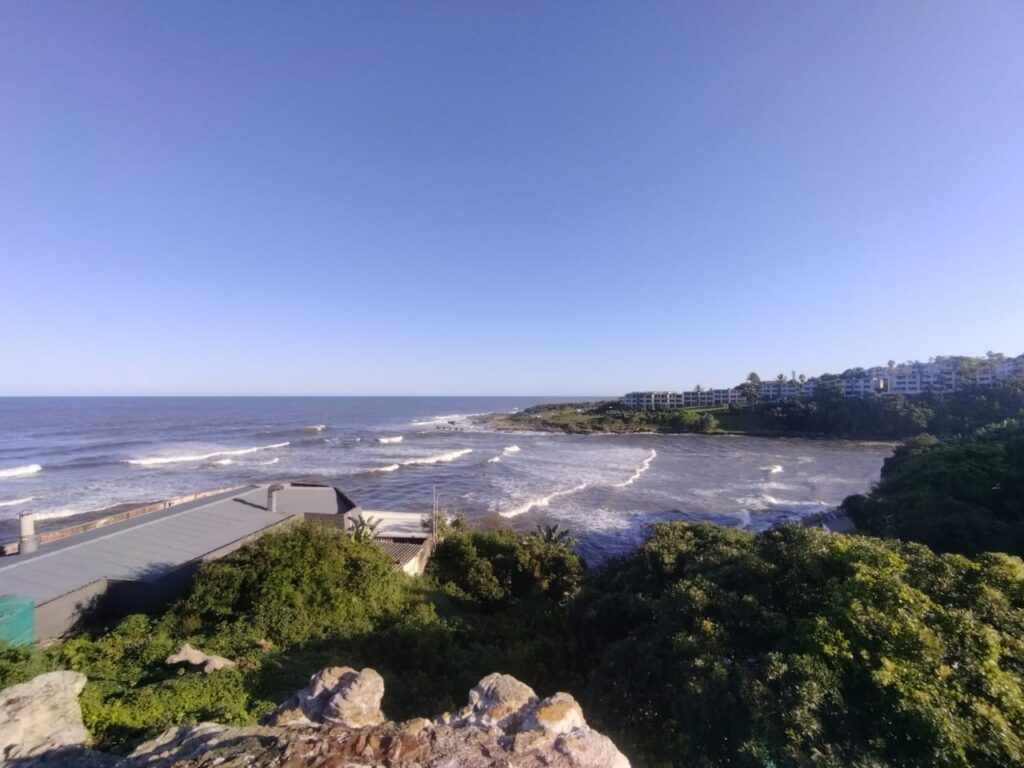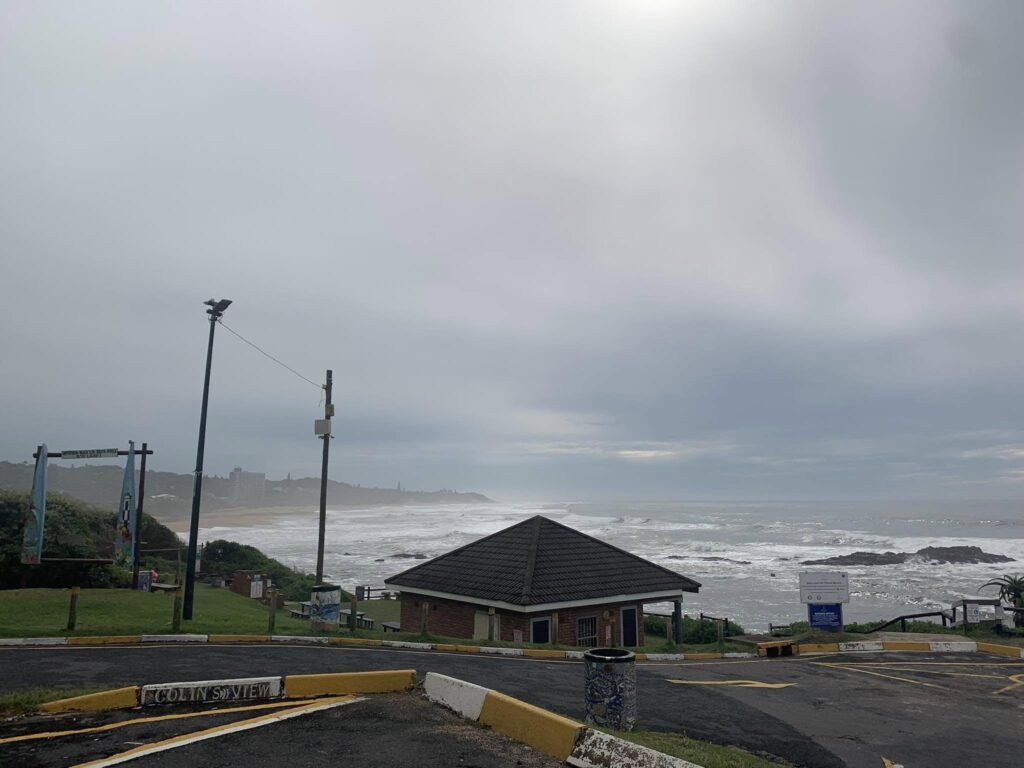Margate, KwaZulu-Natal
Margate is a well-known seaside resort town on the KwaZulu-Natal South Coast. It lies roughly 20 km south-west of Port Shepstone and about 127 km south-west of Durban. With an area of approximately 29.2 km² and a population of about 26,800, Margate serves as a hub for tourists attracted by its subtropical climate, long sandy beaches, and holiday infrastructure. The town sits on undulating coastal terrain, rising towards Margate Airport to the west. Its coastline is part of the “Hibiscus Coast” and forms a continuous strand with adjacent Manaba Beach to the north and Ramsgate to the south. Margate’s climate is humid subtropical: hot, humid summers with significant rainfall and warm but milder winters. Average summer highs reach around 26–27 °C, with December typically the wettest month. Winters remain warm by temperate standards, with daytime highs around 21 °C and nighttime lows rarely dipping below 16 °C. This lush, wet climate helps support the region’s green landscapes and outdoor lifestyle.
History of Margate
Margate’s modern history began in 1908 when an English surveyor, Henry Richardson, laid out the town and named it after the English seaside town of Margate in Kent. Originally, the area had been a large farm called “Inkongweni,” but in 1919, owner Hugh Balance subdivided it into plots, advertising it as a future resort. In 1922, the town made international news with the mysterious “Margate Monster” – the washed-up carcass of a large, white, hairy sea creature. Though unverified, the event drew global curiosity and briefly put Margate on the map.
The town grew steadily through the mid-20th century: Margate was proclaimed a township in 1941 and a municipality by 1947. By the 1950s, it was hailed as one of the most progressive holiday resorts in South Africa. Since then, Margate has continued to develop as a holiday and retirement destination, balancing its resort-town heritage with a growing permanent community. Today it is a popular domestic tourism destination, especially during school holidays and festive seasons.
Geography and Climate
Margate is nestled on KwaZulu-Natal’s South Coast in the Ugu District, with the Indian Ocean to its east. The nearby river that meets the sea here is called the Nkhongweni, meaning “place of entreaty.” The terrain is gently rolling; it rises to its highest point near Margate Airport, about 152 m above sea level. Much of the land in and around Margate is used for housing or holiday accommodation, but it also retains patches of indigenous coastal forest and grassland. The coastline features broad sandy beaches and dunes, backed in places by rocky reefs or estuarine mouths.
Margate’s climate is humid subtropical, typical of the KwaZulu-Natal coast: summers (October–March) are warm and humid with frequent afternoon thunderstorms, while winters (June–August) are warm and relatively dry. Rainfall is fairly evenly spread through the year, totaling about 1000–1100 mm annually. The wettest months are typically November to March, whereas winter months (June/July) average well under 50 mm each. The warm ocean keeps nights mild and moderates temperature swings, making year-round beach and outdoor activities very feasible.
Attractions and Landmarks
Margate is prized for its natural and leisure attractions. Its broad, sandy beaches (many with Blue Flag status) are a top draw, as is the abundance of wildlife reserves and family-friendly parks nearby.
Beaches
The main Margate Beach on Marine Drive and neighboring stretches are popular for swimming, surfing, and beach sports. In total, there are several Blue Flag beaches on the South Coast around Margate, including Margate Main Beach, Manaba Beach to the north, and nearby Trafalgar and Lucien Beaches to the south. These beaches meet strict environmental and safety standards and offer amenities like lifeguards, boardwalks, and picnic areas. The clear ocean is excellent for snorkeling and catching seasonal marine spectacles, such as the annual sardine run.
River Valley Nature Reserve
A 70-hectare protected area of coastal forest and stream valley right in Margate’s center. It is a popular spot for nature walks and birdwatching. Trails wind through dense forest, along clear rivers, and around picnic sites. Wildlife such as impala, nyala, porcupines, and many bird species can be seen here. The reserve provides a green oasis within the town, offering a respite from the beach crowds.
Riverbend Crocodile Farm
Located just outside Margate toward Shelly Beach, this 9-hectare crocodile farm is home to dozens of Nile crocodiles, terrapins, and snakes. Visitors can walk among the crocodile pools and watch feeding demonstrations. The farm also has facilities like a coffee shop and reptile museum, making it a fun family visit.
Pure Venom Reptile Park
Just south of Margate, Pure Venom is Africa’s largest reptile farm. It showcases a huge collection of reptiles, including pythons, cobras, mambas, crocodiles, tortoises, and exotic birds. The park offers daily snake shows and reptile feedings, giving visitors an up-close look at these animals. It’s a top destination for families and anyone intrigued by reptiles.
Butterfly Valley
A butterfly conservatory on the outskirts of Margate (Ramsgate), this dome houses hundreds of tropical butterflies in a garden setting. Visitors stroll through the greenhouse environment and see dozens of species of butterflies fluttering about. The attraction also has a small craft shop and picnic area.
Margate Art Museum
Situated near Margate Main Beach, this public art gallery highlights local and KwaZulu-Natal artists. The museum hosts rotating exhibitions of contemporary paintings, sculpture, crafts, and photography. It also runs educational programs and a children’s art corner, showcasing the region’s artistic talent and heritage.
Beaver Creek Coffee Estate
About 45 minutes’ drive inland, Beaver Creek is South Africa’s southernmost coffee plantation. Tours of the 700-acre estate show the coffee-growing process, and visitors can sample freshly roasted coffee and homemade ice cream. The on-site restaurant overlooks coffee fields and the Umtamvuna River gorge, offering a scenic rural escape from the coastal bustle.
Other Attractions
Nearby attractions include the Uvongo Waterfall, the Oribi Gorge (world-class hiking and zip-lining), and various golf courses such as Margate Country Club. In town, the Casino Theatre ruins and local craft markets add variety. Margate’s beaches also host beach-side markets, fishing piers, and art installations. Overall, Margate offers both classic beach fun and a range of nature and wildlife experiences.
Local Culture and Demographics
Margate’s permanent population is culturally diverse. About 47% of residents are Black African and 47% are White, with Indian/Asian and Coloured minorities. First-language speakers are roughly one-third English, with sizable Xhosa, Afrikaans, and Zulu-speaking communities. This mix reflects both the indigenous Zulu heritage of the region and migration from elsewhere in South Africa. The town’s culture blends coastal Zulu influences with the lifestyle of a holiday resort town. Margate hosts a mix of local traditions and tourist amenities: one sees Zulu dancers or craft markets alongside Irish pubs and beach bars. The community includes long-time residents as well as seasonal visitors and retirees. During summer and holiday periods, the town comes alive with festivals and holidaymakers.
Tourism Infrastructure
Margate is built around tourism, and its infrastructure reflects that. The main road, Marine Drive, through town is lined with hotels, guesthouses, restaurants, bars, and shops. Major hotels include the historic Margate Hotel on Marine Drive and the beachfront Desroches Hotel. There are also many self-catering apartments, B&Bs, and holiday villas along the coast, catering to families and holidaymakers.
Restaurants and nightlife thrive to serve tourists. Along Marine Drive and nearby streets, one finds seafood restaurants, steakhouses, pizza bars, and cafes. Popular eateries include The Grove, Aura, Keg & Chicken, and Senzi’s on Faya. Bakeries, coffee shops, and casual venues abound as well. The selection is broad, including fast food, ice cream parlors, sports pubs, and fine-dining seafood establishments.
Shopping options range from basic to modern. The Hibiscus Mall is the town’s main indoor mall, featuring groceries, clothing, and chain stores. Nearby shopping centres include Margate Centre and Margate Mall. For larger malls, residents often drive north to Shelly Beach, home to the South Coast Mall and Shelly Centre. Weekend arts-and-crafts markets also spring up, offering local crafts and food. Local operators offer tours and activities, including boat charters for dolphin and whale watching, deep-sea fishing expeditions, guided nature hikes, and shark cage diving trips. The nearby Wild Coast Sun casino and resort provides entertainment and convention facilities.
Events and Festivals
Margate and the surrounding South Coast host numerous annual events. One hallmark is the annual sardine run (June–July), when billions of sardines migrate past the coastline. This natural spectacle attracts scuba divers and boat tours.
Other events include markets, sports, and music festivals, such as the African Arts & Culture Festival (Chilla Nathi Festival) each November. In December/January, the “Love Summer” beach programme offers free beach games and competitions for all ages. Christmas markets, beach parties, and live music festivals further enrich the event calendar. During Easter and summer peaks, Marine Drive becomes a focus of activity with concerts, reggae festivals, and pop-up venues.
Nightlife and Entertainment
Margate has a vibrant nightlife, especially during holiday seasons. Along Marine Drive and the beachfront, one finds pubs, dance clubs, and bars. Notable venues include Senzi’s on Faya, The Village Bar & Grill, The Galleon, and The Pump House at Manaba Beach. Many restaurants convert into informal bars at night, with live music common on weekends. In peak holiday weeks, open-air beach parties and beach concerts are common. The nearby Crown Casino at Wild Coast Sun draws nightlife crowds with gaming, shows, and themed club nights. Nightlife caters to families, young holidaymakers, and retirees alike.
Economy and Key Industries
Margate’s economy is dominated by tourism and services. The hospitality industry is the largest employer. Retail trade, shops, and malls serve locals and tourists alike. The surrounding region’s economy includes agriculture, timber, and commercial fishing. Construction of holiday homes and retirement estates has been a growth sector, spurred by the N2 Wild Coast Toll Road, which improves connectivity and boosts commerce. Overall, Margate’s economy is predominantly service-based, catering to both residents and tourists.
Real Estate and Property Market
The Margate property market has seen renewed interest as coastal living becomes more in demand. It has become a value-driven investment location, with strong demand for older homes that can be refurbished. Many buyers come from inland areas seeking affordable seaside homes.
Major suburbs vary in pricing, with Uvongo and Shelly Beach seeing average sale prices around R800k–R1.3m. Short-term rental yields are strong during holiday seasons, attracting investors. Residential developments include security estates and mixed-use projects. The housing market is characterized by strong investor interest, affordability, and prospects for growth.
Education and Healthcare
Margate has a full range of educational and medical services. Schools include Hibiscus Primary School, Margate Primary School, Margate Middle School, and private schools such as South Coast Academy. Higher education is limited, but local vocational training centers serve some needs.
Healthcare includes both public clinics and a major private hospital, Netcare Margate Hospital, which provides emergency, surgical, and specialist services. Public healthcare is available at the Margate Municipal Clinic, with referrals to Port Shepstone Regional Hospital or Durban’s King Edward VIII Hospital for serious cases. Pharmacies and medical specialists are available locally.
Transportation
Margate is well-connected by road and air. The R61 (Wild Coast Toll Road) links Margate with Port Shepstone/Durban and Port Edward. The R620 (Marine Drive) connects Margate with Uvongo, Manaba Beach, and Ramsgate. Local taxis, shuttle services, and ride-hailing operate in town.
Margate Airport is a small regional airport offering flights to Johannesburg, providing a fast link for tourists. The nearest major international airport is Durban’s King Shaka International. Intercity buses run daily routes to major cities. Within town, metered taxis, rental cars, cycling, and tour shuttles are common.
Lifestyle and Cost of Living
Margate offers a laid-back beach-town lifestyle with a warm climate year-round. Outdoor activities such as swimming, fishing, surfing, and hiking are central to daily life. Sports clubs and community events keep locals engaged.
The cost of living is generally moderate. Housing is more affordable than in Durban or Johannesburg. Groceries, utilities, and services follow national averages. Eating out and leisure activities are reasonably priced. Healthcare and schooling costs align with other private-sector rates in KwaZulu-Natal. Holiday crowds can push prices up seasonally, but off-peak living is quiet and budget-friendly.
Margate combines natural charm with modern conveniences. Its residents and visitors enjoy a tropical coastal climate, good beaches, and a sense of community. It is a destination for tourists seeking classic beach vacations and a location with lifestyle appeal for locals and investors.

